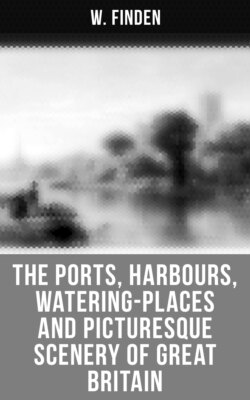Читать книгу The Ports, Harbours, Watering-places and Picturesque Scenery of Great Britain - W. Finden - Страница 32
На сайте Литреса книга снята с продажи.
CASTLE OF HOLY ISLAND.
FROM THE WESTWARD.
ОглавлениеTable of Contents
The Castle of Holy Island stands on a steep rock, about half a mile to the eastward of the Abbey. It is wholly inaccessible, except by a winding pass cut through the rock on the south side. The date of its foundation is unknown; but it is supposed to have been first built by the monks, as a place of refuge against the piratical attacks of the Danes, who frequently annoyed them, and twice burnt their abbey. The most memorable event in the meagre history of this castle is its capture for the Pretender, by two men, Launcelot Errington, and his nephew Mark, in 1715. The garrison at that time consisted of a sergeant, a corporal, and ten or twelve men. Errington, who was master of a little vessel then lying in the harbour, invited the sergeant, and such of his men as were not on duty, to drink with him on board of his ship. The invitation being accepted, he plied them so well with brandy as to render them incapable of opposition. Framing an excuse for going ashore, he proceeded to the castle with his nephew, and succeeded in turning out the old gunner, the corporal, and two soldiers, being all that were on duty. He then shut the gates, and hoisted the Pretender's colours, but being disappointed in the succour which he expected, and a party of the king's troops arriving from Berwick, he and his nephew made their escape over the castle walls, and endeavoured to conceal themselves among the rocks and sea-weed, to the south-eastward of the castle till it was dark, when they intended to swim to the mainland. In consequence of the rising of the tide, they were obliged to swim while it was yet light, and, being perceived by the soldiers, they were taken, and conveyed to Berwick gaol, from which, however, they broke out before they were brought to trial, and escaped to France. On the suppression of the rebellion they took the benefit of the general pardon, and returned to England.
Holy Island is of an irregular form. Its greatest length, including a low sandy point, which stretches out towards the west-north-west, is about two and a half miles. Its mean breadth does not exceed a mile and a half.
Holy Island harbour is a small bay or haven on the south side of the island, between the castle and the ruins of the monastery. On the bar, which is about a mile distant from the town, there is about nine feet at low water at spring-tides. The flood then sets with a strong current in the channel between the island and the mainland; and at high-water there is twenty-four feet on the bar. There is no lighthouse on Holy Island, but there is a beacon on the "Heugh"—a hill between the town and the harbour—on which, in bad weather, when pilots cannot get off, a flag is hoisted during the time of tide that ships may safely enter. In gales of wind from the eastward, coasting vessels sometimes seek shelter in Holy Island harbour, and find good anchorage before the town in three fathoms at low-water.
The Staples and Farn islands, with the rocks and shoals between them and Holy Island, render the in-shore navigation of the coast of Northumberland, from North Sunderland point to the mouth of the Tweed, extremely intricate and hazardous; and the corporation of the Trinity House, London, caution all masters of ships, and especially strangers to the coast, not to attempt sailing within those islands and shoals; more particularly on account of the various settings of the rapid tide which runs in the different sounds between the islands.
A visit to the Farn and Staple islands, from Bambrough or Holy Island, forms a pleasant excursion in fine weather, more especially when the eider ducks are sitting, which is from about the middle of May to the latter end of July. These birds, which are seldom seen, and do not breed to the southward of the Farn islands, are also known in the neighbourhood by the name of St. Cuthbert's ducks. Their eggs, and the fine down with which they line their nests, are collected and sold by the person who rents the islands, which are also the haunt of several other species of water-fowl, such as the sheldrake, the cormorant, and the shag, with auks, guillemots, terns, and gulls. Solan geese also visit the Farn islands, but do not breed there, commonly making their appearance early in spring, and departing before May.
BERWICK. FROM THE SOUTH-EAST
